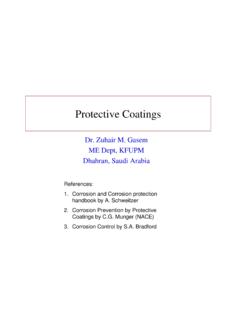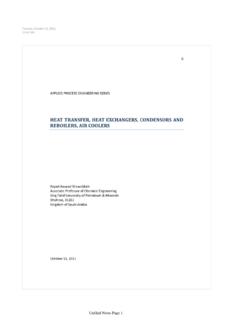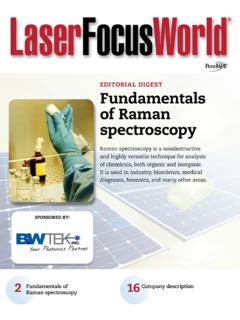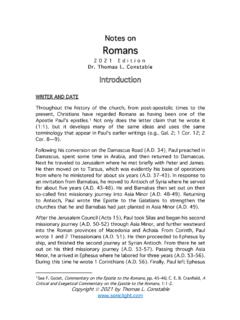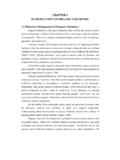Transcription of Chapter 8-DYES-THE CHEMISTRY AND APPLICATIONS
1 1 chapter 8 DYES: THE CHEMISTRY AND APPLICATIONSP rofessor Bassam El Ali2 Chapter 8 OBJECTIVES INTRODUCTION COLORANTS CLASSIFICATION OF DYES TEXTILE FIBERS THE APPLICATION OF DYES INTERMEDIATES MANUFACTURE OF DYESP rofessor Bassam El Ali3 INTRODUCTION Dyes are colored organic compounds that are used to impart color to various substrates, including paper, leather, fur, hair, drugs, cosmetics, waxes, greases, plastics and textile materials. Indigo, the oldest known dye was used by the ancient Egyptians to dye mummy clothes. Tyrian purple, obtained from Murex snails found near the city of Tyre, was used by the Romans to dye the togas of the Bassam El Ali4 INTRODUCTION The dye industry has always been highly competitive; the industry has lately experienced major setbacks in terms of profitability and overall attractiveness particularly in Europe and the United States. Major changes have taken place during the last 20 years, and today Asia (India, Japan, Korea and China) has become the largest dyestuff market, accounting for about 42% of the value of the global dyestuff market.
2 World demand for dyes and organic pigments is forecast to increase per year to more than $ 14 billion in 2004. Professor Bassam El Ali5 Chapter 8 OBJECTIVES INTRODUCTION COLORANTS CLASSIFICATION OF DYES TEXTILE FIBERS THE APPLICATION OF DYES INTERMEDIATES MANUFACTURE OF DYESP rofessor Bassam El Ali6 COLORANTS The two major types of colorants produced today are dyes and pigments. Pigments both inorganic and organic types, are almost always applied in an aggregated or crystalline-insoluble form that requires a binder to form a coating on the surface of a substrate. Pigments do not interact with the substrate and hence do not destroy the crystal structure of the substrate. 3 Professor Bassam El Ali7 COLORANTS Dyes are normally water-soluble or water dispersible organic compounds that are capable of being absorbed into the substrate destroying the crystal structure of the substance. The dye molecules are usually chemically bonded to the surface and become a part of the material on which it is applied.
3 The primary use of dyes is in the textile industry, although substantial quantities are consumed for coloring, such diverse materials as leather, paper, plastics, petroleum products, and Bassam El Ali8 COLORANTS To be of commercial interest, dyes must have high color intensity and produce dyeing of some permanence. The color intensity of the dye molecule depends on how strongly it absorbs radiation in the visible region, which extends from 400 to 700 nm. It was observed earlier that only some types of organic structures give rise to color. Professor Bassam El Ali9 COLORANTS The partial structures necessary for color (unsaturated groups that can undergo - * and n- * transitions) were called chromophores:CC , CC , , , NN , NO2 , CO It was also observed that the presence of some other groups caused an intensification of color. These groups are called auxochromes.
4 The auxochromes are groups that can not undergo - * transitions, but can undergo transition of n electrons: -OH, -OR, -NH2, -NHR, -NR2, -X4 Professor Bassam El Ali10 Chapter 8 OBJECTIVES INTRODUCTION COLORANTS CLASSIFICATION OF DYES TEXTILE FIBERS THE APPLICATION OF DYES INTERMEDIATES MANUFACTURE OF DYESP rofessor Bassam El Ali11 CLASSIFICATION OF DYES Dyes may be classified according to their chemical structure or by the method by which they are applied to the substrate. The dye manufacturers and dye chemists prefer the former approach of classifying dyes according to chemical type. The dye users, however, prefer the latter approach to of classification according to application method. Classification by application or usage is the principal system adopted by the Color Index ( ). The classification of dyes according to their usage is summarized in Table , which is arranged according to the application classification.
5 Professor Bassam El Ali12 CLASSIFICATION OF DYEST able Application Classification of Dyes Class Principal substrates Method of application Chemical Types Acid Nylon, wool, silk, paper, inks, and leather Usually from neutral to acidic dyebaths Azo(including premetalized), anthraquinone, triphenylmethane, azine, xanthene, nitro and nitroso Azoic components and compositions Cotton, rayon, cellulose acetate and polyester Fiber impregnated with coupling component and treated with a solution of stabilized diazonium salt Azo Basic Paper, polyacrylonitrile, modified nylon, polyester and inks Applied from acidic dyebaths Cyanine, hemicyanine, diazahemicyanine, diphenylmethane, triarylmethane, azo, azine, xanthene, acridine, oxazine and anthraquinone Direct Cotton, rayon, paper, leather and nylon Applied from neutral or slightly alkaline baths containing additional electrolyte Azo, phthalocyanine, stilbene, and oxazine Disperse Polyester.
6 Polyamide, acetate, acrylic and plastics Fine aqueous dispersions often applied by high temperature/pressure or lower temperature carrier methods; dye may be padded on cloth and baked on or thermofixed Azo, anthraquinone, styryl, nitro, and benzodifuranone Fluorescent brighteners Soaps and detergents, and all fibers, oils, paints, and plastics From solution, dispersion or suspension in a mass Stilbene, pyrazoles, coumarin, and naphthalimides 5 Professor Bassam El Ali13 CLASSIFICATION OF DYESFood, drug, and cosmetic Foods, drugs, and cosmetics Azo, anthraquinone, carotenoid and triarylmethane Mordant Wool, leather, and anodized aluminum Applied in conjunction with Cr salts Azo and anthraquinone Oxidation bases Hair, fur, and cotton Aromatic amines and phenols oxidized on the substrate Aniline black and indeterminate structures Reactive Cotton, wool, silk.
7 And nylon Reactive site on dye reacts with functional group on fiber to bind dye covalently under influence of heat and pH (alkaline) Azo, anthraquinone, phthalocyanine, formazan, oxazine and basic Solvent Plastics, gasoline, varnishes, lacquers, stains, inks, fats, oils, and waxes Dissolution in the substrate Azo, triphenylmethane, anthraquinone, and phthalocyanine Sulfur Cotton and rayon Aromatic substrate vatted with sodium sulfide and reoxidized to insoluble sulfur-containing products on fiber Indeterminate structures Vat Cotton, rayon, and wool Water-insoluble dyes solubilized by reducing with sodium hydrogensulfite, then exhausted on fiber and reoxidized Anthraquinone (including polycyclic quinines) and indigoids Professor Bassam El Ali14 Acid Dyes Acid dyes are water-soluble anionic dyes, containing one or more sulfonic acid substituents or other acidic groups.
8 An example of the class is Acid Yellow 36. Acid dyes are applied from acidic dye baths to nylon, silk, wool, and modified acrylics. They are also used to some extent for paper, leather, ink-jet printing, food, and cosmetics. The dyeing process is reversible and may be described as follows:SO3HN NNHDye- + H+ + F ib er D y e- H+ FiberProfessor Bassam El Ali15 Acid Dyes The ionic bonding between the dye and the fiber is the result of reaction of the amino groups on the fiber with acid groups on the dye. Generally the fastness of this dye depends on the rate with which the dye can diffuse through the fiber under the conditions of washing. Metal complex (cobalt or chromium) acid dyes are used mainly on wool for improved Bassam El Ali16 Azoic Dyes Azo dyes contain at least one azo group (-N=N-) attached to one or often two aromatic rings. They are produced on textile fibers (usually cotton, rayon and polyester), by diazotization of a primary aromatic amine followed by coupling of the resulting diazonium salt with an electron-rich nucleophile (azocoupling).
9 A variety of hues can be obtained by proper choice of diazo and coupling components. Professor Bassam El Ali17 Azoic Dyes The production of bluish red azoic dye from the following two components is an example. C H 3 O N O 2 N H 2 A z o i c D i a z o C o m p o n e n t 1 H O C O N H + A z o i c C o u p l i n g C o m p o n e n t 2 CH 3 O N O 2 N N H O CHNHB l u i s h R e d A z o i c D yeProfessor Bassam El Ali18 Basic (Cationic) Dyes Basic dyes are water-soluble and produce colored cations in solution. They are mostly amino and substituted amino compounds soluble in acid and made insoluble by the solution being made basic. They become attached to the fibers by formation of salt linkages (ionic bonds) with anionic groups in the fiber. They are used to dye paper, polyacrylonitrile, modified nylons, and modified polyesters. 7 Professor Bassam El Ali19 Basic (Cationic) Dyes In solvents other than water, they form writing and printing inks.
10 The principal chemical classes are triaryl methane or xanthenes. Basic Brown 1 is an example of a cationic dye that is readily protonated under the pH 2 to 5 conditions of Brown 1 Professor Bassam El Ali20 Direct Dyes Direct dyes are water-soluble anionic dyes, but are not classifiedas acid dyes because the acid groups are not the means of attachment to the fiber. They are used for the direct dyeing of cotton and regenerated cellulose, paper and leather. They are also used to dye union goods (mixed cotton, and wool or silk) and to a lesser extent nylon fiber. Most of the dyes in this class are polyazo compounds, along with some stilbenes, phthalocyanines and oxazines. Professor Bassam El Ali21 Direct Dyes The solubility of the dye in the dye bath is often reduced by adding common salt or Glauber s salt. The presence of excess sodium ions favors establishment of equilibrium with a minimum of dye remaining in the dye bath.





